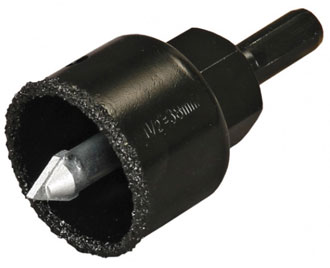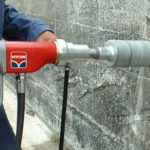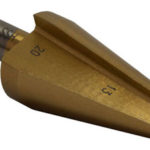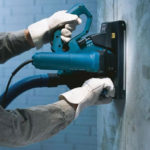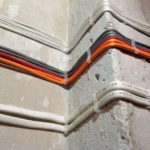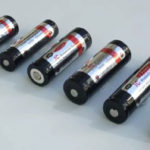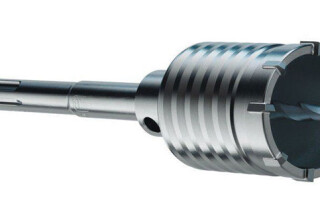When installing hidden electrical wiring in new buildings or in houses after major repairs, it is necessary to drill large diameter holes in the walls of concrete, brick for installing socket boxes. In this case, a drill, puncher or drilling rig is used, in which a special crown for socket boxes is installed. This is a cylindrical nozzle with strong cutting segments. When rotated at high speed, the concrete crown easily penetrates the wall, forming holes for socket boxes with smooth, even edges.
Content
How the crown is arranged
At home, crowns are installed on a puncher or a powerful (more than 800 W) drill. For industrial purposes, drilling rigs are used. The tool is either electric or pneumatic.
Its design consists of three elements:
- Shank. At one end it has a thread for winding the nozzle and a hole for installing a centering drill.The other end is attached to a drill or puncher. They sell shank extensions for rotary hammers with various types of cartridges (SDS Plus, SDS Max).
- Centering drill of cylindrical or conical shape. It securely fixes the nozzle during drilling. The drill is often blunt, it is periodically changed. The conical shape of the drill is used with extended shanks.
- The crown is a piece of pipe, on one side of which there is a cutting edge, and on the other, a flange or shank for mounting in a chuck, perforator or drill. Holes are made in the side walls of the crown for the socket to remove debris when drilling in concrete. On it from 6 to 16 pieces. cutting tips that provide fast drilling at high speeds. The cutting fragments are made of hard materials that easily cut stone, concrete, brick, tile or porcelain stoneware.
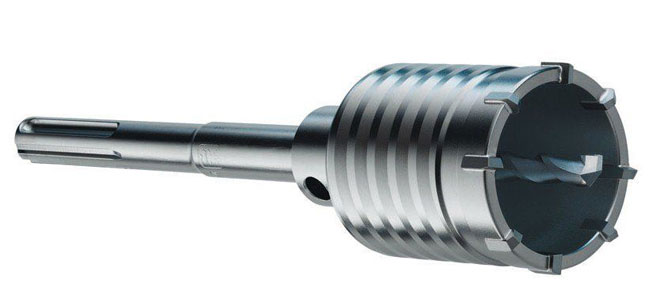
One-piece design nozzles are also sold, designed for long-term work.
Hole size for sockets
When planning drilling work, it is necessary to choose the diameter and size of the bit correctly so that the holes made exactly correspond to the dimensions of the socket boxes and sockets to be installed. Large manufacturers offer boxes for sockets with a diameter of 65-68 mm and a depth of 42-47 mm. They require holes in the wall with a diameter of 68 with a drilling depth of up to 60 mm. The standard and most common socket drill bit diameter is 68mm and the working depth is 60mm. The length and diameter can be smaller or larger, for example, 70, 74, 82 mm.
Crown types
Depending on the material to be drilled and the technology, a socket bit is selected.For domestic purposes, cutting parts of drills with various materials of cutting edges are offered:
- Carbide (pobedite or other alloys). On the edge of the cutting edge are soldered hard alloy. Used for dry percussion drilling of several holes at home.
- Tungsten carbide for drilling in stone, concrete, brick, shell rock, ceramic tiles. Not suitable for drilling reinforced concrete, as the cutting edges become unusable when they hit the reinforcement.
- Diamond-coated (diamond) for dry and wet (cooled) shockless drilling. The cutting part is coated with a crumb of technical diamonds. Suitable for reinforced concrete without restrictions on drilling depth and when a large amount of work is required.
According to the type of attachment of the cutting parts to the drills, they are classified according to the shape of the shank:
- with trihedral shanks;
- Nozzles for a drill with hexagonal tips for domestic needs;
- SDS and SDS Plus. Their diameter (10 mm) corresponds to the cartridge sockets of most models of rotary hammers and drills used in everyday life;
- "SDS Top" with a diameter of 14 mm. For medium sized drills;
- "SDS Max" with a diameter of 18 mm for professional equipment.
The shanks must match the chucks of the tool being used.
How to choose
Each novice builder will have to decide how to choose a crown so that it is easy to drill and inexpensive. When choosing them, one should take into account the material of the walls, the drilling method, the size of the holes and their number, and financial costs.
Pobedit and tungsten carbide devices with a small working resource in terms of the number of holes are more affordable.
The diameter of the socket crown must be equal to the diameter of the socket box.
The cutting parts of drills with diamond and tungsten carbide coating are unsuitable for the impact method. The diamond crown is used when drilling holes for socket boxes in stone, granite, concrete, reinforced concrete. It is expensive, but will last a long time and is designed for repeated use.
When drilling concrete, the tool can get on the reinforcement and become unusable. Before choosing the right crown, it is necessary to familiarize yourself with the recommendations of manufacturers for their purpose and operation.
diamond crown
The cutting edge of the cylinders contains separate segments coated with technical diamonds. Diamond grit copes with the hardest materials, even reinforced concrete reinforcement. According to the strength of the spraying, they are marked:
- M - soft spray for drilling durable concrete;
- C - spraying of medium hardness for reinforced concrete;
- T - hard spraying is used when drilling high-quality concrete at low speeds of the drilling rig.
Diamond drill bits for drilling holes are divided into two main types:
- for dry drilling;
- for drilling with liquid cooling of the cutting device.
Using the dry method, a concrete or brick wall is drilled at home in a shockless way, using drills or punchers.
Cooled drills are used in industrial drilling rigs with fluid supply for heat removal. They are designed for large depths of drilling holes or through drilling of walls made of monolithic reinforced concrete, granite or marble.
Dry drilling devices have a number of advantages:
- long period of use;
- high speed drilling holes;
- applicability for drilling walls reinforced with metal meshes;
- minimal dust formation;
- preservation of the integrity of the walls during drilling;
- low noise level.
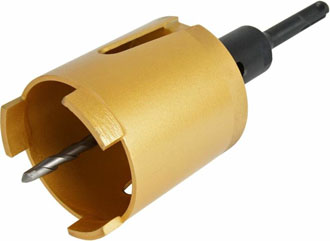
The disadvantages include the high price of nozzles (from 2000 rubles).
victorious
One of the hard alloys of tungsten carbide with cobalt and carbon, called Pobedit in everyday life, is soldered onto the cutting edge of the nozzle.
Pobedit is a durable alloy suitable for impact drilling in simple concrete and brick. When it hits steel reinforcement, the victorious soldering quickly crumbles. Carbide nozzles are actively used at home. The cost of such crowns is from 400 rubles, which is quite suitable for do-it-yourself drilling work.

Tungsten carbide crown
Tungsten carbide bits drill through concrete, brick and tile with equal ease. This is handy when you want to make a hole for a socket box on a tiled wall. The drill is designed to work with a drill or puncher with a power of at least 800 W in an unstressed way. When it hits the reinforcement, the soldering is removed, therefore, when drilling, it is better to use tungsten carbide drills in combination with diamond counterparts of the same outer diameter. The price of tungsten carbide devices is from 250 rubles.
